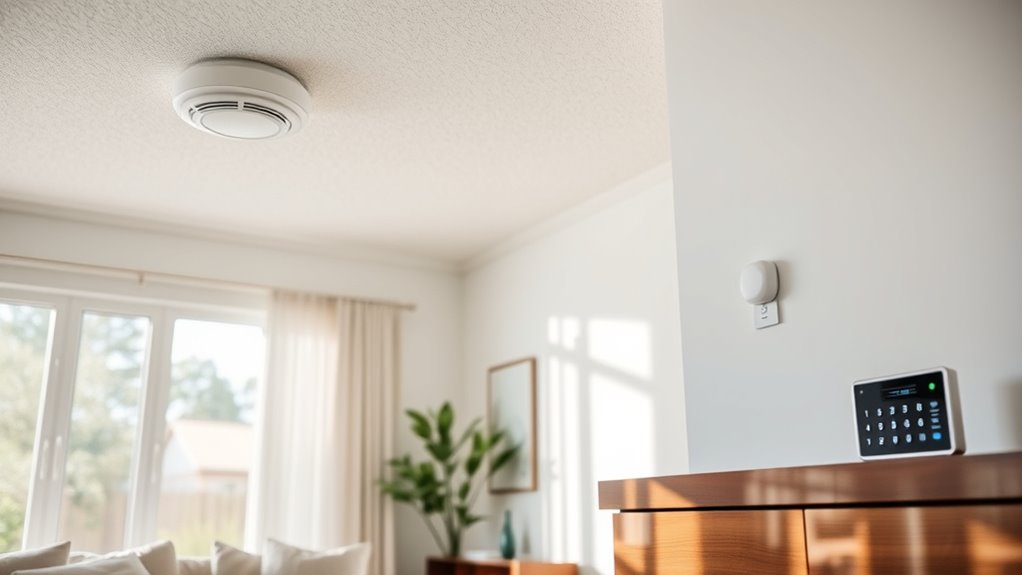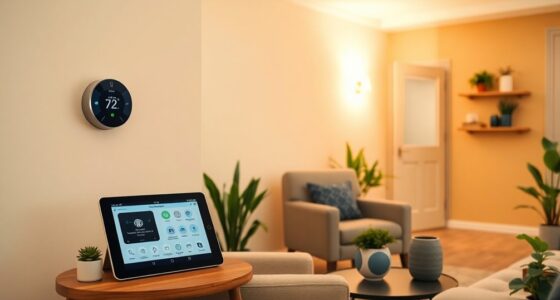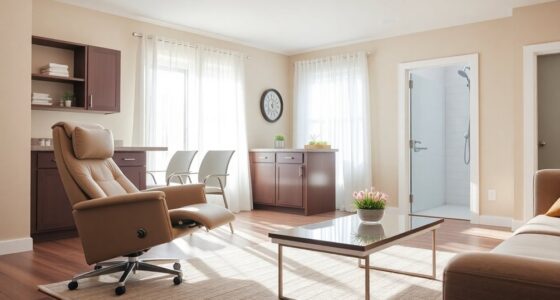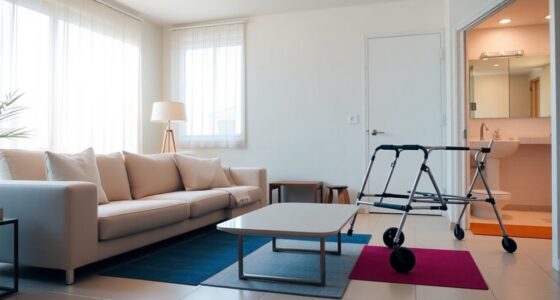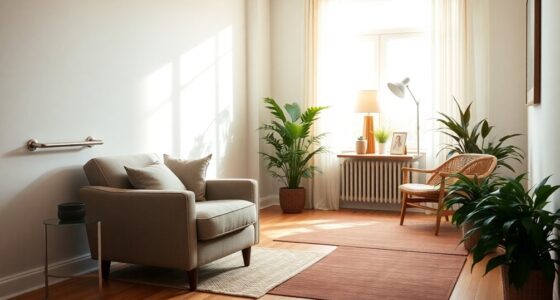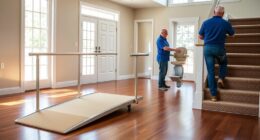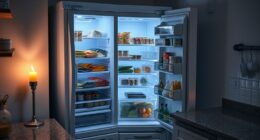Upgrading your home safety starts with installing reliable smoke alarms, carbon monoxide detectors, and advanced security systems. Test these devices regularly, replace batteries yearly, and consider models with longer-lasting or interconnected alarms for better protection. Proper placement on every level and near bedrooms guarantees early warnings. Staying proactive with safety upgrades reduces risks and enhances family security. If you want to learn how to choose the best devices and maintain your systems effectively, keep exploring these essential tips.
Key Takeaways
- Regularly test and replace batteries in smoke and CO alarms annually to ensure reliable detection.
- Upgrade to interconnected or smart alarms for comprehensive coverage and faster alerts throughout the home.
- Mount detectors on every level, especially near bedrooms and common areas, for optimal safety.
- Conduct routine maintenance, check for hazards, and replace outdated alarms to prevent failures during emergencies.
- Develop and practice family emergency plans, including evacuation procedures and safety drills, for effective response.
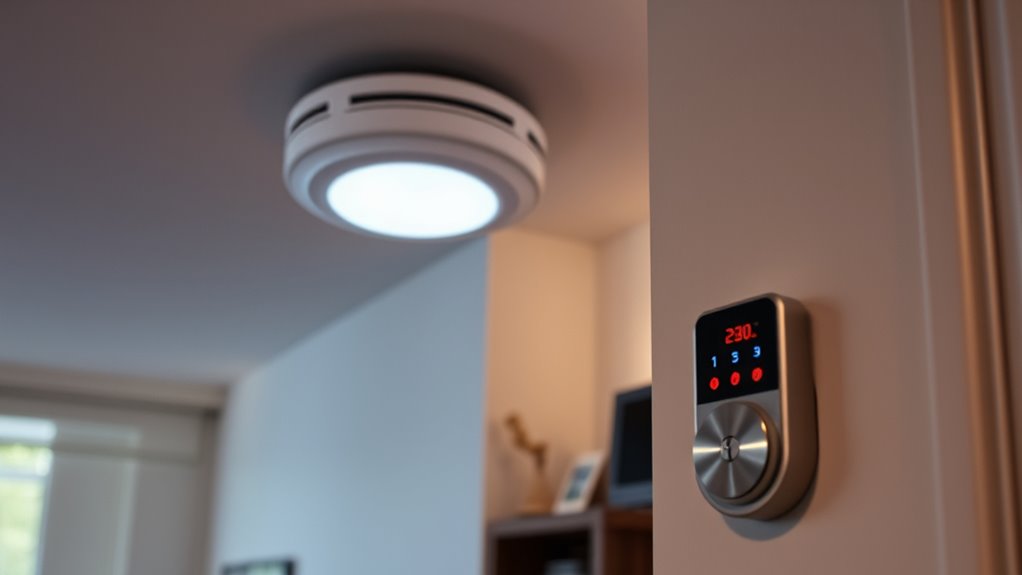
Are you truly doing enough to keep your home safe? Many homeowners overlook the importance of regularly updating safety devices, but doing so is vital for effective fire prevention and emergency preparedness. Smoke alarms and carbon monoxide detectors are your first line of defense against potential disasters, so ensuring they’re functioning properly can make all the difference. If your alarms are outdated or malfunctioning, they may fail to alert you in time, putting your loved ones at risk. Regularly testing each alarm monthly and replacing batteries at least once a year keeps them reliable. Consider upgrading to newer models with longer-lasting batteries or interconnected systems that sound alarms simultaneously throughout the house. This way, you’re better prepared to respond quickly when an emergency strikes.
Regularly test and update smoke and CO detectors to ensure your home’s safety and quick emergency response.
In addition to alarms, investing in quality smoke detectors and CO detectors is essential. Dual-sensor alarms that combine smoke and carbon monoxide detection provide extensive protection, alerting you to multiple threats with a single device. Mount detectors on every level of your home, especially near bedrooms and in common areas, to guarantee maximum coverage. Remember, fire prevention isn’t just about alarms; it involves creating a safe environment by checking for potential hazards, like faulty wiring or overloaded outlets, which can lead to fires. Keeping flammable materials away from heat sources and maintaining a clutter-free space also reduces fire risks. Regular maintenance and timely replacement of safety devices can significantly enhance fire safety in your home. Understanding the contrast ratio of your projector can enhance your viewing experience by ensuring the display produces clear distinctions between dark and light areas, which is crucial for both entertainment and safety in home theater setups.
Emergency preparedness involves more than just installing alarms. It’s about having a clear plan for your family in case of an emergency. Make sure everyone knows how to respond if an alarm goes off—whether it’s evacuating immediately or staying low to avoid smoke inhalation. Practice fire drills regularly so that everyone is confident in their roles. Having an emergency kit ready with essentials like water, first aid supplies, and important documents can save precious time during a crisis. Also, ensure your mobile devices are charged and that you have a way to receive emergency alerts from local authorities. Additionally, being aware of the cost factors associated with home safety upgrades can help you plan and prioritize improvements within your budget. Choosing the right safety devices and understanding their effectiveness can further reduce risks and improve overall safety standards in your home.
Upgrading your home safety isn’t a one-time task; it’s an ongoing process that involves staying vigilant and proactive. Regularly review and update your safety devices, stay aware of new technological advancements, and keep your emergency plans current. By doing so, you’re not only protecting your property but also safeguarding the lives of everyone in your home. Remember, the effort you put into fire prevention and emergency preparedness today can greatly reduce the risk of tragedy tomorrow.
Frequently Asked Questions
How Often Should I Test My Smoke Alarms and CO Detectors?
You should test your smoke alarms and CO detectors monthly to guarantee they’re working properly. During alarm maintenance, check the battery life and replace batteries at least once a year or when the low-battery chirp sounds. Regular testing helps you catch issues early, keeping your home safe. Don’t forget to clean the alarms and replace units every 8-10 years for peak performance and safety.
Can I Install Multiple Alarms in the Same Room?
Installing multiple alarms in the same room is like having a team of watchdogs watching every corner. You can do it for added safety, especially if the room is large. Just guarantee proper alarm placement—mount them high on the wall or ceiling—and consider interconnectivity options so all alarms sound together if one detects danger. This setup maximizes your home’s protection and ensures you’re promptly alerted from anywhere in the room.
What Is the Best Placement for Security Cameras?
You should position your security cameras at strategic camera angles to maximize coverage and minimize blind spots. For outdoor placement, install cameras high on walls or eaves to deter tampering and gain a broad view of your property. Focus on entry points like doors and windows, and avoid placing cameras where they might be obstructed by trees or structures. Proper outdoor placement guarantees you capture clear footage and enhance your overall security.
Are Smart Alarms Compatible With Home Automation Systems?
Smart alarms are designed for easy automation system compatibility, guaranteeing seamless smart alarm integration with your existing setup. You’ll find many models that work well with popular home automation systems like Alexa, Google Home, or Apple HomeKit. When choosing a smart alarm, check its compatibility to ensure smooth automation integration. This way, you can control your fire and carbon monoxide alerts effortlessly through your smart home ecosystem, enhancing safety and convenience.
How Do I Ensure My Alarms Are Maintenance-Free Long-Term?
You want your alarms to stay maintenance-free long-term. To do that, check their battery life regularly and replace batteries as needed, especially if they aren’t rechargeable. Opt for models with long-lasting, sealed batteries or those that alert you when the battery is low. Also, minimize sensor maintenance by cleaning the alarms gently with a soft cloth and avoiding dust buildup, ensuring they function effectively without frequent upkeep.
Conclusion
By investing in smoke alarms, CO detectors, and security systems, you’re gently tending to the unseen threads that keep your sanctuary secure. These upgrades quietly whisper peace of mind into your daily life, creating a subtle layer of protection that’s always there, even when you’re not looking. Embrace these small enhancements, and you’ll find your home becomes a haven where safety’s gentle presence fosters confidence and comfort at every turn.
